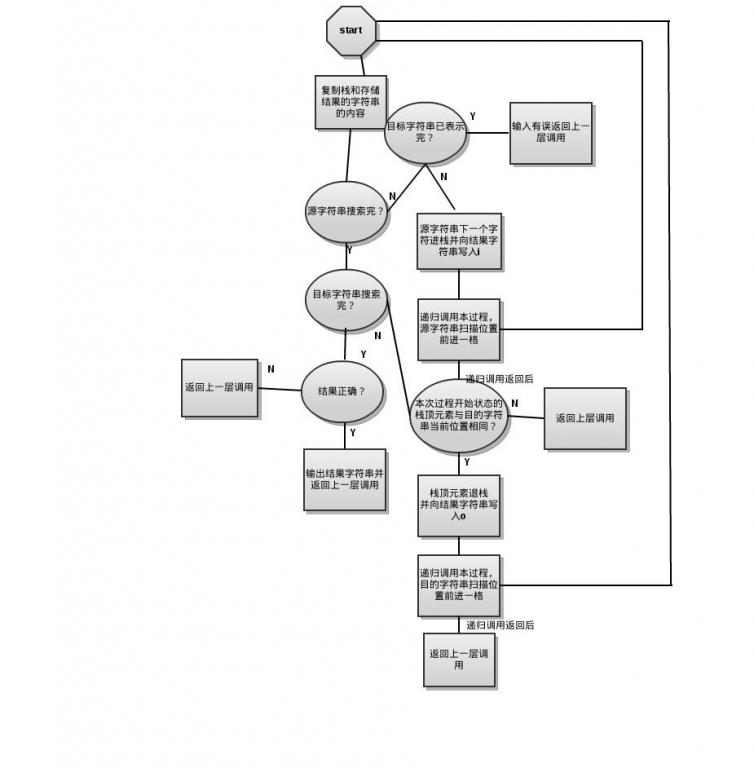ZOJ 1004 Anagrams by Stack 分析与解答
问题:
How can anagrams result from sequences of stack operations? There are two sequences of stack operators which can convert TROT to TORT:
[ i i i i o o o o i o i i o o i o ]
where i stands for Push and o stands for Pop. Your program should, given pairs of words produce sequences of stack operations which convert the first word to the second.
Input
The input will consist of several lines of input. The first line of each pair of input lines is to be considered as a source word (which does not include the end-of-line character). The second line (again, not including the end-of-line character) of each pair is a target word. The end of input is marked by end of file.
Output
For each input pair, your program should produce a sorted list of valid sequences of i and o which produce the target word from the source word. Each list should be delimited by
[ ]
and the sequences should be printed in "dictionary order". Within each sequence, each i and o is followed by a single space and each sequence is terminated by a new line.
Process
A stack is a data storage and retrieval structure permitting two operations:
Push - to insert an item and
Pop - to retrieve the most recently pushed item
We will use the symbol i (in) for push and o (out) for pop operations for an initially empty stack of characters. Given an input word, some sequences of push and pop operations are valid in that every character of the word is both pushed and popped, and furthermore, no attempt is ever made to pop the empty stack. For example, if the word FOO is input, then the sequence:
| i i o i o o | is valid, but |
| i i o | is not (it's too short), neither is |
| i i o o o i | (there's an illegal pop of an empty stack) |
Valid sequences yield rearrangements of the letters in an input word. For example, the input word FOO and the sequence i i o i o o produce the anagram OOF. So also would the sequence i i i o o o. You are to write a program to input pairs of words and output all the valid sequences of i and o which will produce the second member of each pair from the first.
Sample Input
madam adamm bahama bahama long short eric rice
Sample Output
[ i i i i o o o i o o i i i i o o o o i o i i o i o i o i o o i i o i o i o o i o ] [ i o i i i o o i i o o o i o i i i o o o i o i o i o i o i o i i i o o o i o i o i o i o i o i o ] [ ] [ i i o i o i o o ]
说明:
通过栈的进栈、出栈操作描述由第一个源字符串转换到目的字符串。i表示进栈,o表示出栈。输出所有的可能,并且结果按字典顺序排列。anagram意为回文构词法。若源字符串无法转换为目的字符串,则不显示结果。
m进栈,a进栈,d进栈,a进栈,a出栈,d出栈,a出栈,m进栈,m出栈,m出栈。即显示结果为:i i i i o o o i o o
这只是一种情况,要求显示出所有的情况。结果由一对"["、“]”包住。
分析:
void anagram(char *p_st, int top, char *p_res, int num, int si, int ti);
p_st指向当前的栈,top指向当前入栈位置,即栈顶元素为p_st[top-1]。p_res指向存储结果的字符串,num为下一个结果的位置。si为当前源字符串的搜索位置,ti为当前目的字符串的搜索位置。
源字符串source和目的字符串target为全局变量。
本过程一开始要对栈和结果字符串进行复制,否则无法得到多个结果且会产生混乱。
流程图为:

优先进栈,写入“i”,并递归调用,之后返回后再看是否原栈顶元素是否与当前目的字符串搜索位置匹配,再在合适地方写入“o”,然后递归调用。每一次过程调用先考虑“i”的情况再考虑“o”的情况保证了输出结果按字典排序输出。
基本上此过程有3个主要过程,检验是否产生结果,进栈并处理,出栈并处理。
在Ubuntu下没有找到一个好用的画图工具,于是使用了一个在线绘制流程图的app:Gliffy(http://www.gliffy.com/)。非常不错!
代码(gcc)



